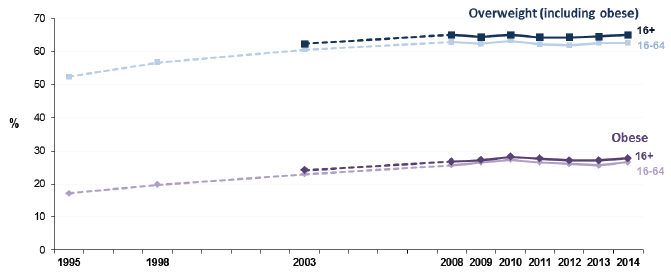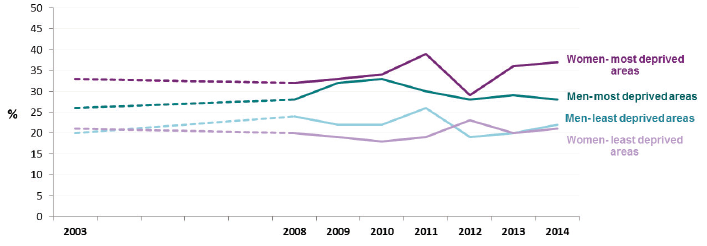Obesity indicators 2015
Latest data for indicators selected to monitor progress for our Prevention of Obesity Route Map (2010). Most indicators are updated up to 2014, but for some indicators data are more or less up-to-date than this.
This document is part of a collection
Adult overweight and obesity
Indicator Source: Scottish Health Survey
Latest Results
- In 2014, 65% of adults aged 16 and over were overweight, including 28% who were obese.
- There has been an increase in the proportion who are overweight or obese among both sexes (aged 16-64) since 1995, from 52% to 63%. Most of this increase was seen between 1995 and 2008, with figures remaining broadly stable since then.
- Men were more likely than women to be overweight including obese (69% compared to 61%), whereas obesity prevalence was higher among women than men (29% compared to 26%).
- Overweight (including obesity) prevalence was lowest among young people aged 16-24 (35%). A significantly higher proportion of those aged 25-34 were overweight (57%), with further increases with age up to age 65-74. Over three quarters of those aged 55-74 were overweight including obese (77-78%), as were 72% of those in the oldest age group (75+).
Figure 1. Proportion of adults overweight and obese, 1995-2014 (ages 16-64) and 2003 to 2014 (ages 16+)

- Although inequalities in overweight prevalence vary by sex and over time, obesity rates are consistently higher in Scotland's most deprived areas compared to the least deprived (Figure 2). The gap has been particularly pronounced for women in recent years, with 16 percentage points difference in 2014 (rates were 37% in the most deprived areas compared to 21% in the least deprived).
Figure 2. Proportion of adults (16+) obese by gender and area deprivation[2],
2003-2014

About This Indicator
Desired Outcome:
Majority of Scotland's adult population in normal weight range throughout adult life.
Definitions:
Overweight - BMI 25+
Obese - BMI 30+
Geography available:
National, Health Board.
Equalities data:
Breakdowns by all six equalities groups are possible. Breakdowns for 2008-2011 are available in the Scottish Health Survey topic report on equality groups published in October 2012. http://www.scotland.gov.uk/Publications/2012/10/8988
Rationale for including this indicator:
The aim of this indicator is to monitor changes in the proportion of Scotland's adult population who are overweight and obese. It is used to identify any different patterns (and hence need for specific policy focus) amongst men and women of different ages. It is a long term measure of success of the Route Map.
Factors influencing this indicator:
- Diet, physical activity and sedentary behaviour are strongly associated with BMI.
- For women, obesity is significantly associated with area-level deprivation (SIMD) but not for men.[3]
Contact
Email: Daniel Adams
There is a problem
Thanks for your feedback